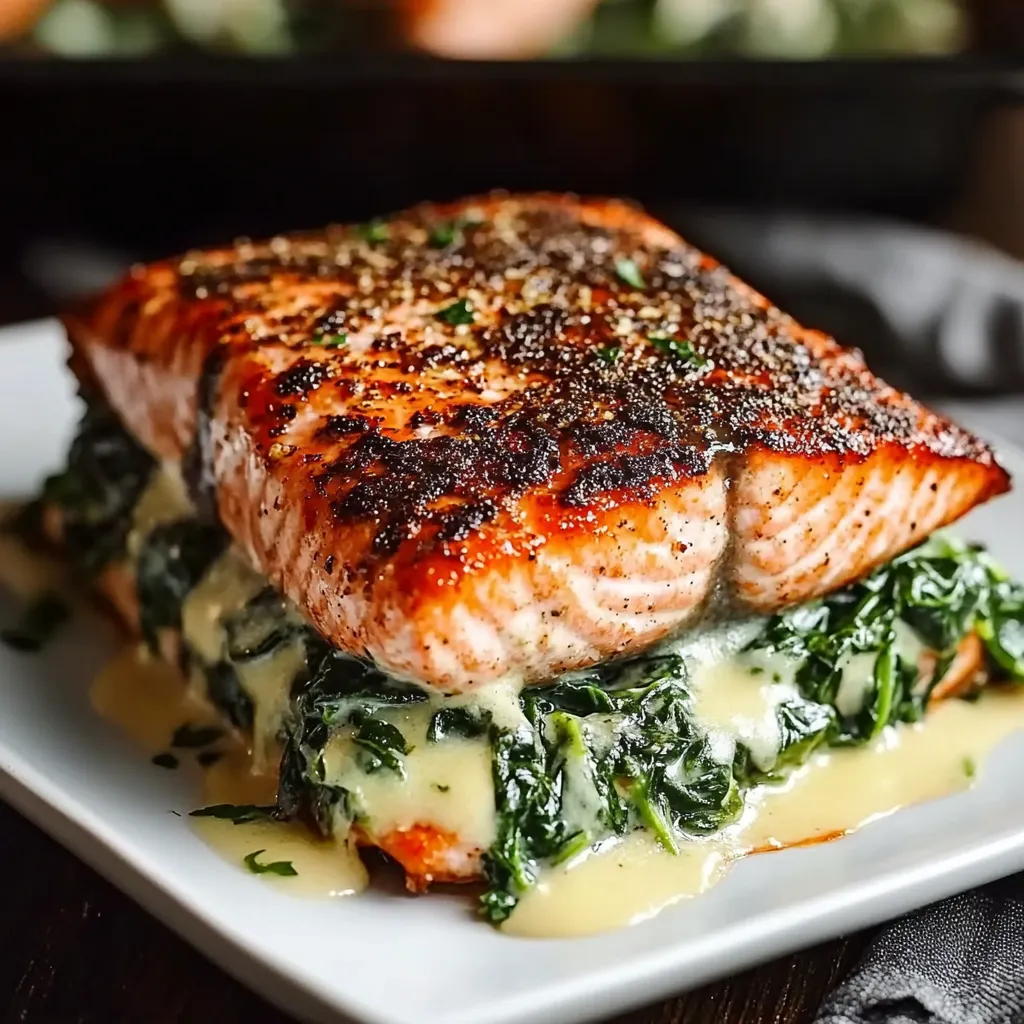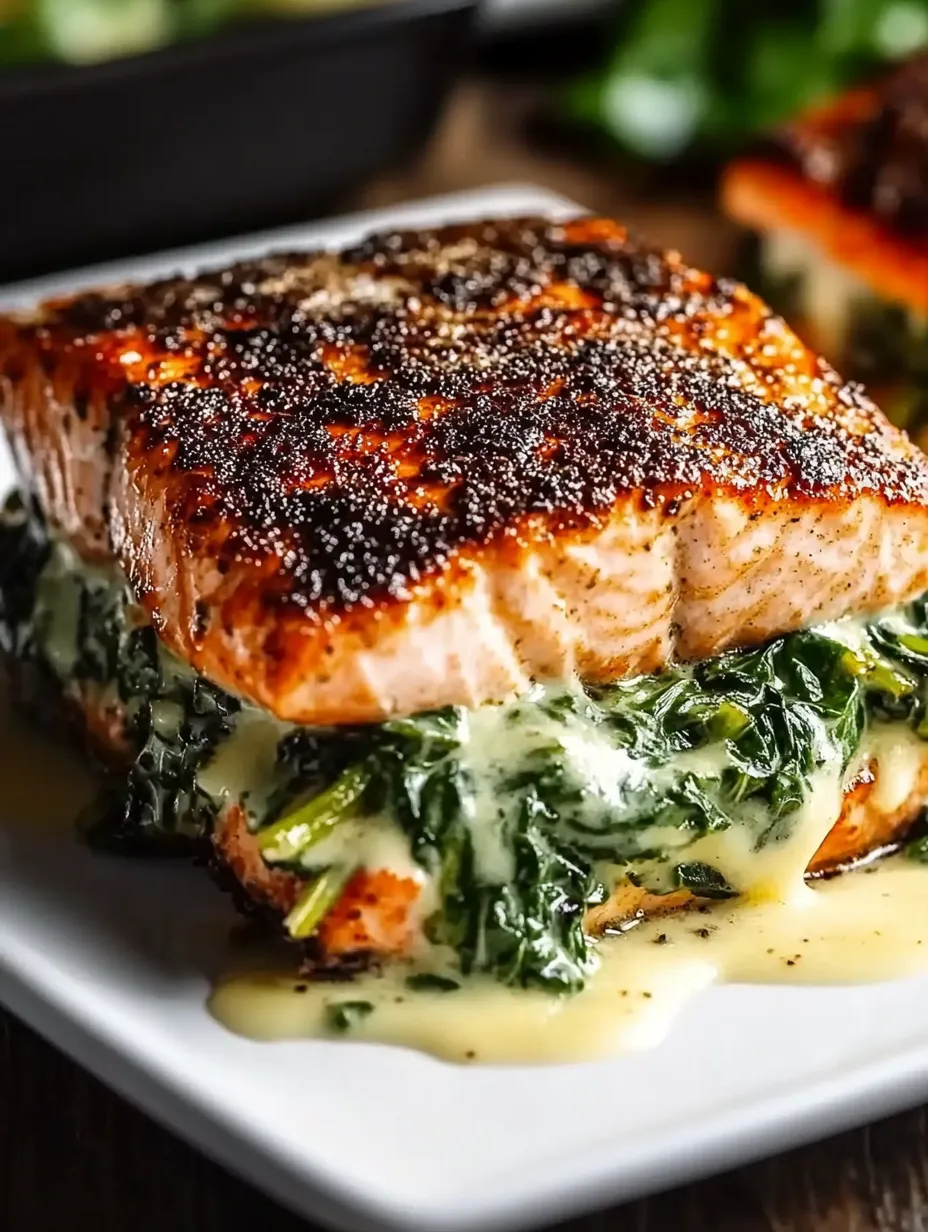 Pin
Pin
This blackened salmon stuffed with spinach and Parmesan is one of my favorite ways to turn a regular weeknight into something special without spending hours in the kitchen. The crispy blackened crust locks in succulent flavor while the creamy spinach and cheese inside keeps each bite moist and irresistible. If you want to impress family or guests but need a meal that is quick and manageable this fits the bill perfectly.
I started making this when I needed a quick wow dinner for my in-laws it quickly became a monthly request in our house. Even my picky brother-in-law asks if I can make the filling just for toast.
Ingredients
- Salmon fillets: fresh and skinless these should be firm to the touch and smell clean avoid any with a strong fishy odor
- Fresh spinach: gives moisture and vibrancy bagged baby spinach wilts fastest and is easy to rinse
- Cream cheese: softened this binds the filling to keep it creamy and rich I like using full-fat for best texture
- Grated Parmesan cheese: adds salty nutty flavor always reach for a block and grate yourself for better melt
- Minced garlic: fresh is best here for bold aroma avoid pre-minced for less bitterness
- Olive oil: use for searing a fruity robust variety deepens the flavor
- Paprika: sweet smoked paprika gives a warm color and subtle depth try Spanish paprika if available
- Garlic powder: rounds out the alliums and enhances savoriness
- Onion powder: another layer of sweet savoriness for the rub
- Black pepper: choose freshly ground for more aroma
- Salt: to taste flaky sea salt brings out flavors without overpowering
- Lemon wedges: for finishing a zesty squeeze at the table brightens up every bite
Step-by-Step Instructions
- Prepare the Spinach Filling:
- Cook the spinach in a skillet over medium heat stirring frequently until it wilts and reduces in volume which takes about three minutes. Drain any liquid thoroughly then transfer to a bowl and mix with the softened cream cheese Parmesan minced garlic salt and black pepper. Stir until the mixture is smooth and well combined with no visible lumps.
- Prepare the Salmon:
- Lay each salmon fillet flat on a cutting board. Using your sharpest small knife gently cut a deep horizontal slit along the side of each fillet creating a pocket for the filling. Be careful not to cut all the way through so the bottom remains intact and can hold the stuffing.
- Stuff the Salmon:
- Use a spoon to pack the spinach and cheese mixture inside the pocket of each salmon fillet. Fill as much as possible but avoid overstuffing so the filling does not spill out during cooking.
- Season the Salmon:
- In a small bowl blend together paprika garlic powder onion powder black pepper and salt until uniform. Using your fingers or a small spoon gently coat the tops and sides of each stuffed salmon fillet with this blackening mixture.
- Cook the Salmon:
- Heat the olive oil in a large skillet over medium-high until shimmering. Place the stuffed fillets top side down first and sear undisturbed for two to three minutes until the top develops a crisp blackened crust. Flip carefully and sear the other side for another two minutes.
- Bake the Salmon:
- Transfer the seared fillets to a preheated oven set at three hundred fifty degrees Fahrenheit. Bake for ten to twelve minutes or until the salmon is just cooked through and easily flakes with a fork. The filling should be bubbling and the top should be golden.
- Serve:
- Arrange each fillet on a plate with lemon wedges on the side and let everyone squeeze fresh lemon over their portion. Serve immediately so the crust stays crisp.
 Pin
Pin
I always use freshly grated Parmesan because one time I tried the pre-shredded kind and the filling was grainy and just did not melt right. My favorite part is that first slice when you see the creamy green and gold swirl inside.
Storage Tips
If you have leftovers place the stuffed salmon in an airtight container and refrigerate for up to two days. To reheat bake gently at low heat or use a skillet over low so the fish stays moist and the crust crisp. Freezing is not recommended because the texture of the creamy filling can change after thawing.
Ingredient Substitutions
If cream cheese is not available use ricotta or soft goat cheese for a slightly tangier flavor. You can swap out spinach for baby kale or a mix of hearty greens. For the cheese Parmesan can be replaced with Pecorino or Asiago. For added heat sprinkle in some cayenne or smoked chipotle powder to the seasoning mix.
Serving Suggestions
I love pairing this salmon with simply roasted fingerling potatoes or a lemony rice pilaf. A crisp salad with arugula and cherry tomatoes balances the richness. For a more elegant touch add a drizzle of balsamic reduction or a dollop of pesto on the plate.
Cultural and Historical Context
Blackened seasoning comes from Louisiana Cajun cooking which uses bold spices and high heat to create a flavorful crust on fish or chicken. Stuffing fish is a classic Mediterranean technique for keeping seafood juicy. This recipe brings both traditions together for a dish that feels both familiar and new.
Recipe Questions & Answers
- → How do I keep the salmon moist while cooking?
To prevent dryness, avoid overcooking and remove the salmon from the oven once it flakes easily with a fork. Searing first seals in moisture, and baking gently finishes the fish.
- → Can I substitute frozen spinach for fresh?
Yes, thaw frozen spinach and squeeze out excess liquid before combining it with the cheeses and garlic for the filling.
- → What sides pair well with this dish?
Roasted vegetables, steamed rice, or a light salad make excellent accompaniments, adding color and balance to the meal.
- → Is grilling a good alternative to pan-searing and baking?
Grilling adds a subtle smoky flavor and works well as long as the fillets are handled carefully to maintain the stuffing.
- → How do I make the filling extra creamy?
Ensure the cream cheese is softened before mixing and fully integrate it with the spinach and Parmesan for a smooth texture.
- → What’s the best way to cut pockets in the salmon?
Use a sharp knife to slice horizontally into the thickest part of the fillet, stopping before cutting all the way through to create a secure pocket.